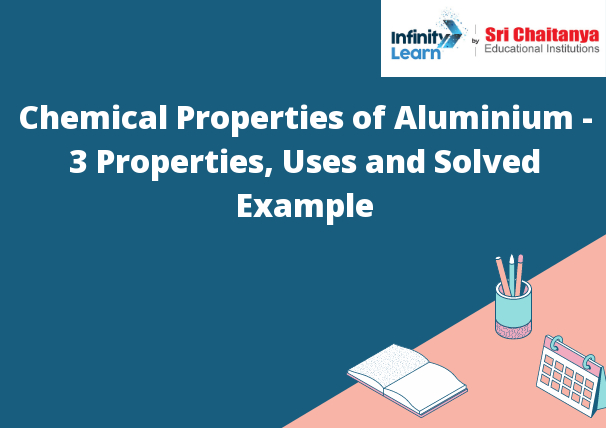Table of Contents
Three Properties Of Aluminium
Chemical Properties of Aluminium – 3 Properties Uses and Solved Example:
Aluminium is a light metal that is corrosion-resistant, ductile, and malleable. It has a relatively low melting point and is a good conductor of electricity.

Aluminium (aluminum in American and Canadian English) is a chemical element with the symbol Al and atomic number 13. Aluminium has a density lower than those of other common metals, at approximately one third that of steel. It has a great affinity towards oxygen, and forms a protective layer of oxide on the surface when exposed to air. Aluminium visually resembles silver, both in its color and in its great ability to reflect light. It is soft, non-magnetic and ductile. It has one stable isotope, 27Al; this isotope is very common, making aluminium the twelfth most common element in the Universe. The radioactivity of 26Al is used in radiodating.
Chemically, aluminium is a post-transition metal in the boron group; as is common for the group, aluminium forms compounds primarily in the +3 oxidation state. The aluminium cation Al3+ is small and highly charged; as such, it is polarizing, and bonds aluminium forms tend towards covalency. The strong affinity towards oxygen leads to aluminium’s common association with oxygen in nature in the form of oxides; for this reason, aluminium is found on Earth primarily in rocks in the crust, where it is the third most abundant element after oxygen and silicon, rather than in the mantle, and virtually never as the free metal.
Uses Of Aluminium
Aluminium is a silver-white metal that is very light and soft. It is the most common metal in the Earth’s crust. Aluminium is used to make cans, foil, and other containers. Aluminium is also used in cars, trains, and planes.
The Biological Role Of Aluminium
Aluminium is a trace element that is found in all body tissues. It has a number of important biological roles, including the following:
– Aluminium is essential for the function of several enzymes, including those involved in energy production and protein synthesis.
– Aluminium is involved in the regulation of gene expression.
– Aluminium is necessary for the formation of healthy bones and teeth.
– Aluminium is required for the absorption of essential minerals, including calcium and magnesium.
Chemical Properties of Aluminium – 3 Properties, Uses and Solved Example.







